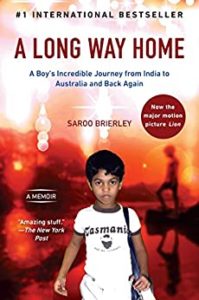Saroo Brierley’s memoir, A Long Way Home, is an astounding story of a little boy lost in India, a vast and often dangerous country.
Saroo’s family was poor. His father had abandoned the family, leaving his mother, two older brothers, Saroo, and a little sister to fend for themselves in a one-room hut. The mother worked, but the pittance she made often wasn’t enough to feed the family. The two older boys could sometimes find little jobs, but mostly they foraged and begged for food.
Saroo, five years old, was often the only caretaker of his baby sister. But even Saroo would go into the neighborhood to beg or sneak food from the many vendor stalls in their poor neighborhood.
One evening in 1987 Saroo and his oldest brother took off on a borrowed bicycle and rode into the closest town. There was often food to be scavenged near the train depot. His brother temporarily ditched the bike, promising Saroo that he would be back soon. But he didn’t return. In searching for his brother, Saroo boarded a train, but the train took off 1,000 miles across India to Calcutta, one of the most dangerous cities in the world. Uneducated, unable to speak the local dialect or even to remember the name of his hometown, the little boy wandered the streets, foraging for food, drinking water from a filthy river, desperately searching for safe places to sleep.
Authorities eventually placed Saroo in an orphanage and he soon was adopted by a loving Australian family. He had a good life in Tasmania, but was often haunted by his childhood memories of India and his family there. Twenty-five years later, with the help of Google Earth and a Facebook group, he was able to put enough of his memory fragments together to figure out where he had come from and possibly find his family.
A Long Way Home is a remarkable, well-written memoir. Brierley tells his story without fanfare, but with gratitude for all who helped him along the way. His memoir is an inspirational story of determination and hope.



